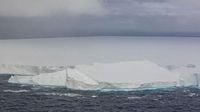After nearly four decades of a remarkable journey across the Southern Ocean, the world’s largest iceberg, A23a, is now in its final days. Once a sprawling frozen titan weighing nearly 1.1 trillion tons and covering an area larger than Rhode Island, A23a has been splintering at an astonishing rate since early 2025. Scientists now predict that by November 2025, this so-called "megaberg" will have vanished entirely, reduced to a scattered field of icy debris and, eventually, nothing more than a memory in satellite archives.
According to The Weather Channel, the iceberg’s rapid demise is a rare and dramatic event, drawing the attention of researchers, mariners, and environmentalists alike. The story of A23a isn’t just about ice; it’s a window into the changing dynamics of Antarctica and the world’s oceans, offering lessons on climate, ecosystems, and the raw power of nature.
The saga of A23a began in 1986, when it calved from Antarctica’s Filchner-Ronne Ice Shelf. For more than 30 years, the iceberg remained stubbornly grounded in the Weddell Sea, pinned to the seafloor by its own immense weight. It wasn’t until 2020 that A23a finally broke free, joining the so-called "iceberg alley"—a conveyor belt of currents that sweeps giant bergs toward the South Atlantic. By early 2025, it had drifted close to South Georgia Island, a remote outpost teeming with penguins and seals.
In January 2025, A23a was still a behemoth. As CNN reported, it weighed almost 1.1 trillion tons and spanned 1,418 square miles (3,672 square kilometers). But the iceberg’s days as the world’s largest were numbered. After spending several months grounded on the continental shelf near South Georgia, it was swept up in May by the powerful Southern Antarctic Circumpolar Current Front (SACCF). This current, notorious for breaking up even the most resilient icebergs, began to take its toll.
"It has been following the strong current jet known as the Southern Antarctic Circumpolar Current Front," said Andrew Meijers, a polar oceanographer with the British Antarctic Survey (BAS), in an interview with CNN. "The iceberg is rapidly breaking up, and shedding very large chunks, themselves designated large icebergs by the US national ice center that tracks these." Satellite images confirmed the carnage: vast slabs calving away, some hundreds of square miles in size, and a blizzard of smaller bergy bits swirling around the main mass.
By September 2025, A23a had lost about 80% of its mass since May, shrinking to roughly 656 square miles (1,700 square kilometers)—just one-fifth of its size eight months earlier, according to CNN. Its drift speed also increased, at times topping 12 miles per day as it rode stronger currents and increasingly rough seas, as reported by Earth.com. The iceberg’s rapid disintegration was further accelerated by its repeated groundings on shallow banks, which added extra stress and hastened the breakup.
"It’s breaking up fairly dramatically," Meijers told Earth.com. "I’d say it’s very much on its way out – it’s basically rotting underneath. The water is way too warm for it to maintain. It’s constantly melting…It won’t be really identifiable within a few weeks." The British Antarctic Survey echoed this prediction, noting that the onset of the southern spring would likely contribute to the remaining fragments melting into mini bergs, soon too small to monitor.
A23a’s journey has not been without consequences. Its presence near South Georgia Island earlier in 2025 raised alarms that it could block penguins and seals from reaching their offshore feeding grounds. "Potentially, it could interrupt their pathway to feeding sites and force the adults to expend more energy to travel around it," Meijers explained to Earth.com. Fortunately, the berg’s drift around the island reduced the immediate risk to the region’s wildlife.
Yet, the iceberg’s demise may also offer unexpected benefits. As A23a melts, it releases micronutrients such as iron into the ocean’s sunlit surface layers, effectively fertilizing phytoplankton blooms that can feed krill, fish, and, ultimately, seabirds and mammals. BAS researchers sampled waters around A23a in December 2023 to gauge its biogeochemical "footprint," finding that iceberg-borne nutrients and upwelling can boost productivity and even enhance carbon sequestration as organic matter sinks to greater depths.
For mariners, however, A23a’s disintegration has been a cause for concern. While a single giant iceberg is easy to track and avoid, a field of smaller, hard-to-detect fragments can pose significant hazards to ships. "As it breaks up over time, the smaller bergs are much harder to track," Meijers warned. Fishing operators may temporarily write off entire regions until the ice debris disperses.
Meanwhile, the title of the world’s biggest iceberg has passed to D15a, currently located near Australia’s Davis research station in Antarctica. D15a measures around 1,160 square miles (3,000 square kilometers) and, for now, appears to be staying put, Meijers told CNN. As A23a continues to fragment, it will quickly drop down the ranks of the world’s largest icebergs, and eventually disappear from tracking altogether.
The story of A23a is also a reflection of broader changes in Antarctica. While iceberg calving is a natural part of the polar ice life cycle, the context has shifted. "Icebergs, including megabergs like this one, are a completely normal part of the lifecycle of the Antarctic (and Greenland) ice sheets," Meijers said to Earth.com. However, "observations show that the ice shelves have lost around 6,000 giga (billion) tons of their mass since the year 2000." This loss is "roughly matched by an increase in straight-up melt of the ice shelves," with implications for global sea level and ocean circulation.
Climate change may also be increasing the frequency of large icebergs near South Georgia Island, though there isn’t enough data yet to say whether more megabergs are forming as a direct result of global warming. What’s clear is that Antarctica is extremely vulnerable to warming, and scientists are already seeing dramatic changes in its natural cycles, according to the British Antarctic Survey.
For researchers, A23a’s long journey has been a rare opportunity to witness, measure, and model how a true giant interacts with the Southern Ocean—how it fertilizes, freshens, and fragments, and what that means for the planet. "Icebergs provide interesting natural laboratories for studying ocean physics, chemistry, and ecosystems," Meijers noted. As A23a’s saga draws to a close, the data and insights it leaves behind will continue to inform our understanding of a warming world.
By November, the world’s biggest iceberg will be gone, but its lessons—about resilience, change, and the interconnectedness of Earth’s systems—will endure, shaping science and policy for years to come.


